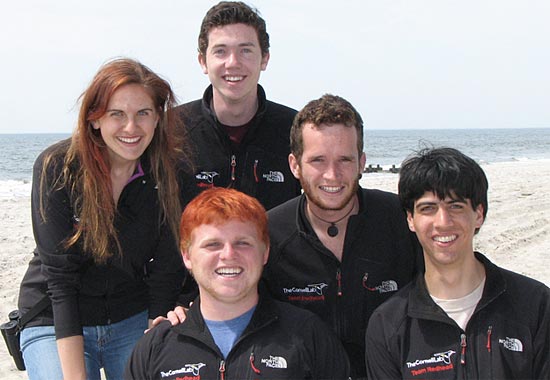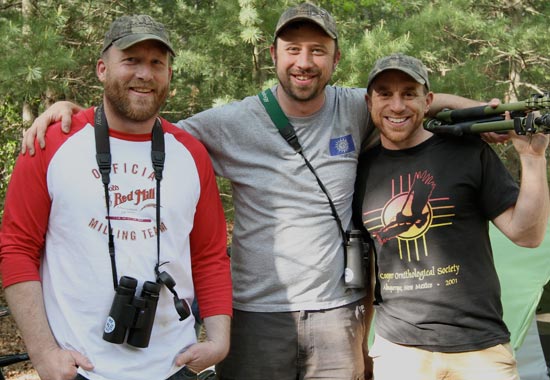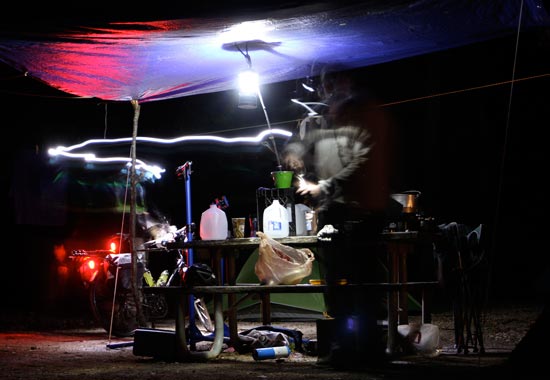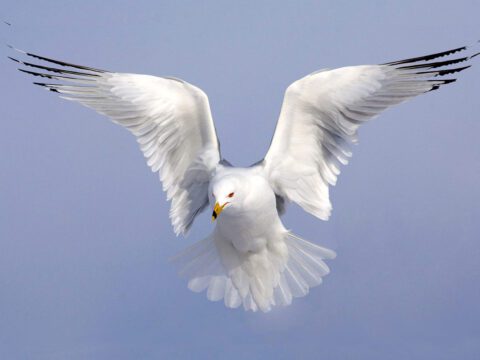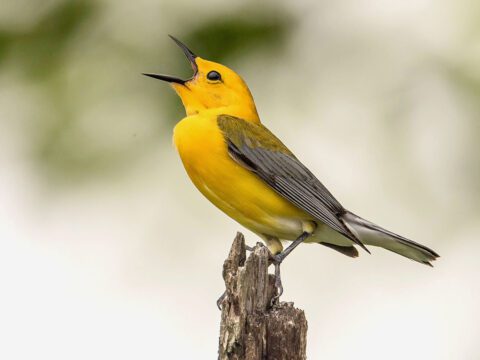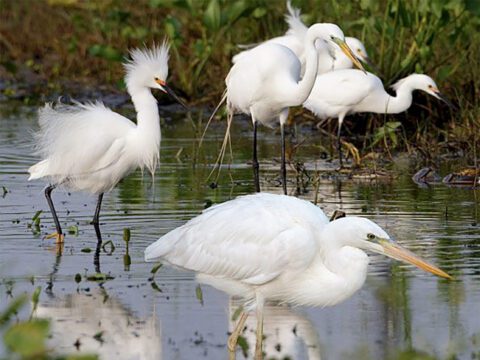World Series results: Epic day of migration finds Cornell Lab teams at front of pack
By Hugh Powell May 15, 2012
Two members of Team Redhead went the extra mile and dyed their hair for the competition. Clockwise from left: Hope Batcheller, Brendan Fogarty, Jack Hruska, Eric Gulson, Ben Barkley. 
The Anti-Petrels in camp before the big day: Hugh Powell, France Dewaghe, Charles Eldermire. Photo by Benjamin M. Clock. 
At just before midnight, the Anti-Petrels were a blur of activity as they prepped for the day's birding. Photo by Benjamin M. Clock.
With hordes of migrant songbirds fluttering in the bushes of southern New Jersey on Saturday, two Cornell teams posted strong finishes in the 29th annual World Series of Birding. The student Redheads team scored 168 species with their new lineup, enough to take second place in the Cape May County division. And the bicycle-powered Anti-Petrels netted 164 species while riding 102 miles, winning the Carbon Footprint Challenge for the third straight year.
But on a day like Saturday, that winning feeling was spread liberally throughout the competition. Birders walked into Sunday’s brunch still reeling and bemused from the onslaught of warblers, thrushes, grosbeaks, and orioles they’d seen—a daylong kaleidoscope of blue, yellow, black, orange, red, and green flashing from the bushes. Almost every team, when asked how their day went, summed it up the way Redheads captain Hope Batcheller did, saying “It was just a really phenomenal day; we had a blast. Several people on the team were like, ‘That’s the best day of birding I’ve ever had.'”
If you ask me, that potential for surprise is why people participate in this conservation fundraiser—to witness a natural spectacle that can occur on a scale that people can scarcely imagine. It can occur, but it’s not guaranteed to occur, and that’s what turns people into bird watchers and conservationists. Serendipity is a feature of nature—it’s the thing that sets natural entertainments apart from the digital and the electronic. A favorite movie is the same every time you watch it. A favorite walk in the woods is different every time, and in that difference is the magic of the world.
Redheads score “phenomenal” day
For the Redheads, good omens arrived before dawn, with a Long-eared Owl and Least Bittern in Tuckahoe marsh. By the time they hit Cape May point at dawn there were “five or ten warblers in every bush,” Hope said (including the aptly named but uncommon Cape May Warbler). An odd call emanating from a grassy field led them not just to a Dickcissel—another coveted mark on the day’s checklist—but also a Bobolink, perched right next to it.
The best days often include a painful miss, but even this had a touch of good humor to it. One of only a handful of Cattle Egrets in southern New Jersey lives right next door to the Redheads’ motel. On Friday it was the first bird they saw on their way out the door, but on Saturday it refused to show. On Sunday morning the egret was right out front on the lawn again, bright and early.
Hope was happy with the performance of the young team and with their route, though she said next year the team might try to time their visits to the coast to hit a tide that produces better shorebirds. The team will have one other hurdle as well: they’ll probably need a new captain, as Hope has plans to study tropical ecology in Costa Rica next spring. But several crackerjack young birders have enrolled at Cornell for next year. This year there was an application process to select team members; next year the students may actually field two teams (the Anti-Petrels want to get them interested in a student bike team).
Anti-Petrels cycle to 164 species
The Anti-Petrels pedaled a similar route to last year but scored a full 20 additional species—evidence of just how blisteringly hot the migration had been the previous night. I’m a member of the team, and the day certainly goes down in my mind as an endless stream of good luck, good weather, and good looks at great birds.
Our highlights included a Black Rail heard in the far distance at Jake’s Landing around 1:30 a.m. Team captain France Dewaghe, who has very sharp ears, picked it out from the background of Whip-poor-will and Marsh Wren calls, but it took a full 15 minutes for Charles Eldermire and me to hear it well enough to count it. Fortunately, the bird was unperturbable and kept calling the whole time. Every so often, I imagine, it turned its tiny bill (these birds are no bigger than tennis balls) toward us and that’s when we heard its unmistakeable kee-kee-kerrr.
I always tell myself never to doubt France’s ears—he’s like Radar O’Reilly on M*A*S*H*, calling out “Louisiana Waterthrush!” or “Prothonotary Warbler!” moments before the rest of us hear the song. But twice that morning we heard strange warbler songs loud and clear—eventually they turned out to belong to a Northern Waterthrush and a Canada Warbler, two species we had never recorded in previous years.
The waterthrush, and the cloud of Magnolia Warblers and Northern Parulas that surrounded it, was our first clue that we were on to an epic day of migration. King Rails called from many of the marshes we rode by; a very rare Black-necked Stilt landed in our main shorebird spot at 5:30 a.m., near a valuable Little Blue Heron and Stilt Sandpiper. Two unusual vireos, Blue-headed and Warbling, showed up in trees virtually next to each other, as well as our World Series nemesis bird, the Rose-breasted Grosbeak, which warbled sweetly from a high branch. The birding was so good that we even managed to find Magnolia Warblers singing dead-on Chestnut-sided Warbler songs—unfortunate actually, since we never did find an actual Chestnut-sided for our list. We left Heislerville at just after 9 a.m. with 112 species on our list.
Our low point came at lunchtime, when we made a special side trip to boost our chances for Gull-billed Tern. We’d seen them there in the driving rain on Wednesday, but the only terns that appeared were slender, long-tailed Forster’s Terns hunting fish from the river channels. We ate Nutella and privately wondered if our luck had turned. One mile down the road, France rode over a broken bottle and we had our second flat of the day (the first had come at 2:30 a.m.).
We got back on track on our way out to the great saltmarshes of Avalon and Nummy Island. The Cattle Egret that eluded the Redheads kindly showed up for us, and so did Yellow-crowned Night-Herons, Whimbrels, American Oystercatchers, and a welcome Common Loon. Red Knots positively glowed in the afternoon light. Our scopes even picked up the glossy backs of horseshoe crabs mating in the shallow water—their eggs are the reason the knots stop here every spring. We even spent a couple of spare minutes watching a Peregrine Falcon flying steep U-shaped dives at another peregrine on the ground, possibly trying to steal a kill.
Our day ended with one more disappointment—no Parasitic Jaegers were to be found harrying terns in the tidal rips off Cape May Point—but this was buttressed by a good run of swallows and an American Crow calling on an island filled with Fish Crows. We finished the day amid the thick mosquitoes of Higbee Beach, scoring Purple Sandpipers alongside Ruddy Turnstones on the rocks and hearing a Barred Owl calling from the woods—the one regular bird species we had missed in the morning. As usual, France heard it first.
Everyone here at the Cornell Lab would like to thank all our sponsors, donors, and supporters for being with us during this Big Day season—from Carl Zeiss Sports Optics and their support of Team Sapsucker, to Bob’s Red Mill and the yummy granola that kept our pedals turning on Saturday, and the many of you who donated, followed us on Facebook, and cheered us on. Thank you.
And if you’re curious about what it’s like to ride bikes and go birding, here’s a short time-lapse of the last couple of miles out to Cape May Meadows and then to Higbee Beach for sunset…

All About Birds
is a free resource
Available for everyone,
funded by donors like you
American Kestrel by Blair Dudeck / Macaulay Library
